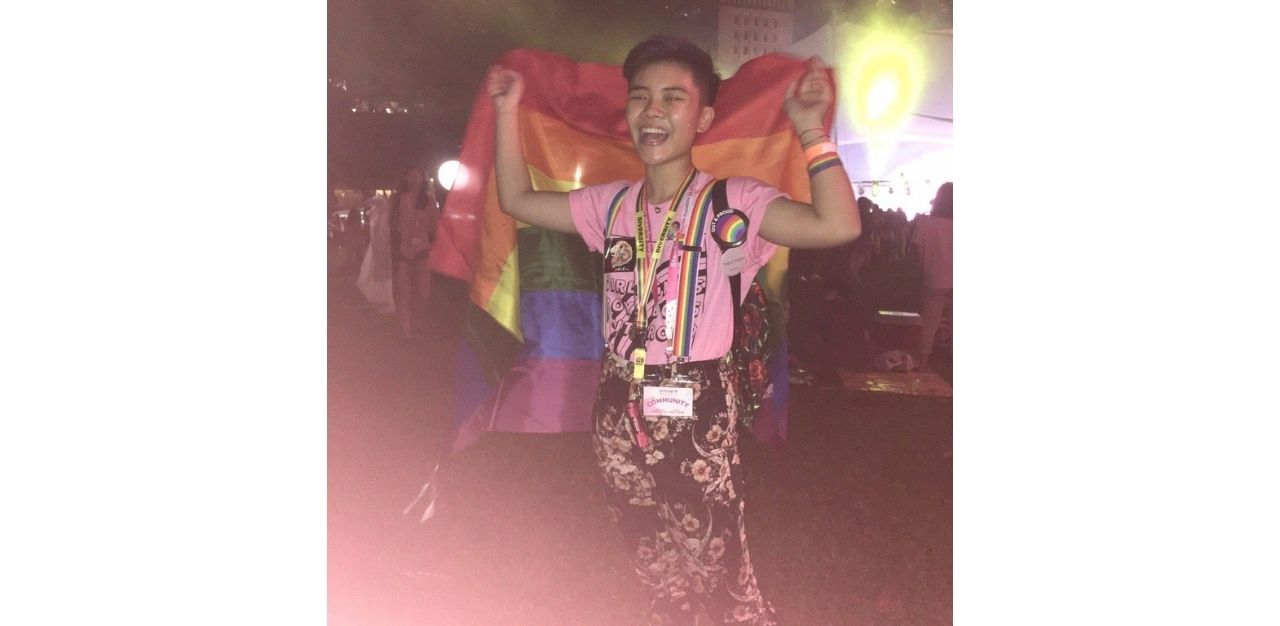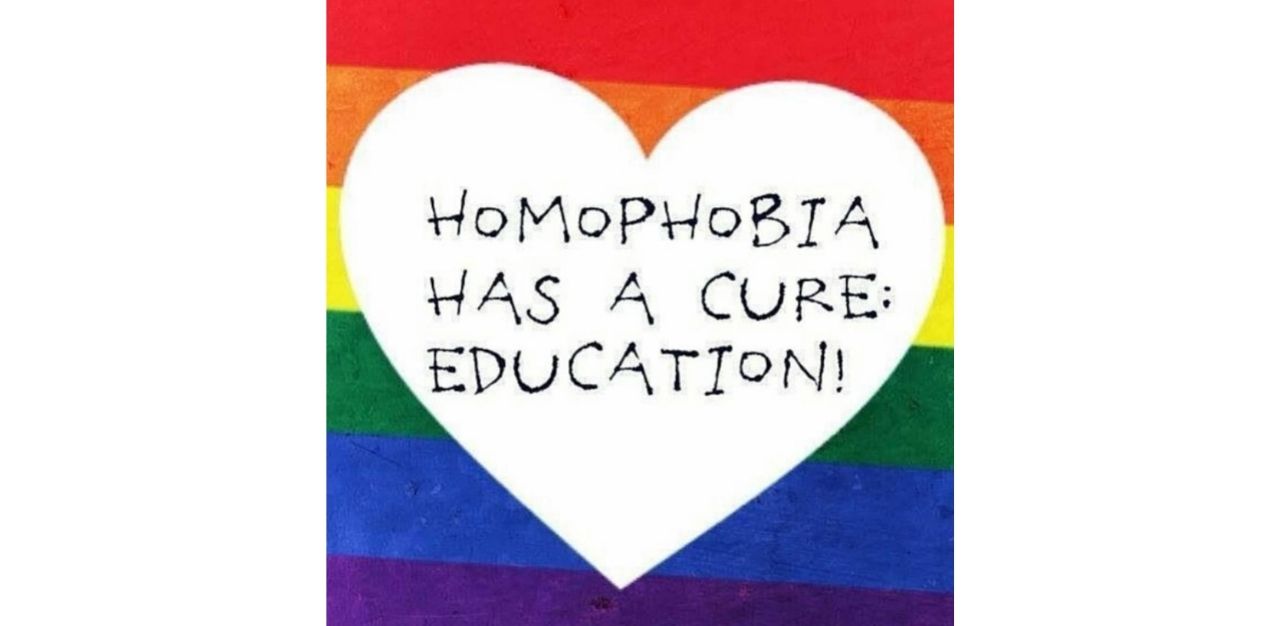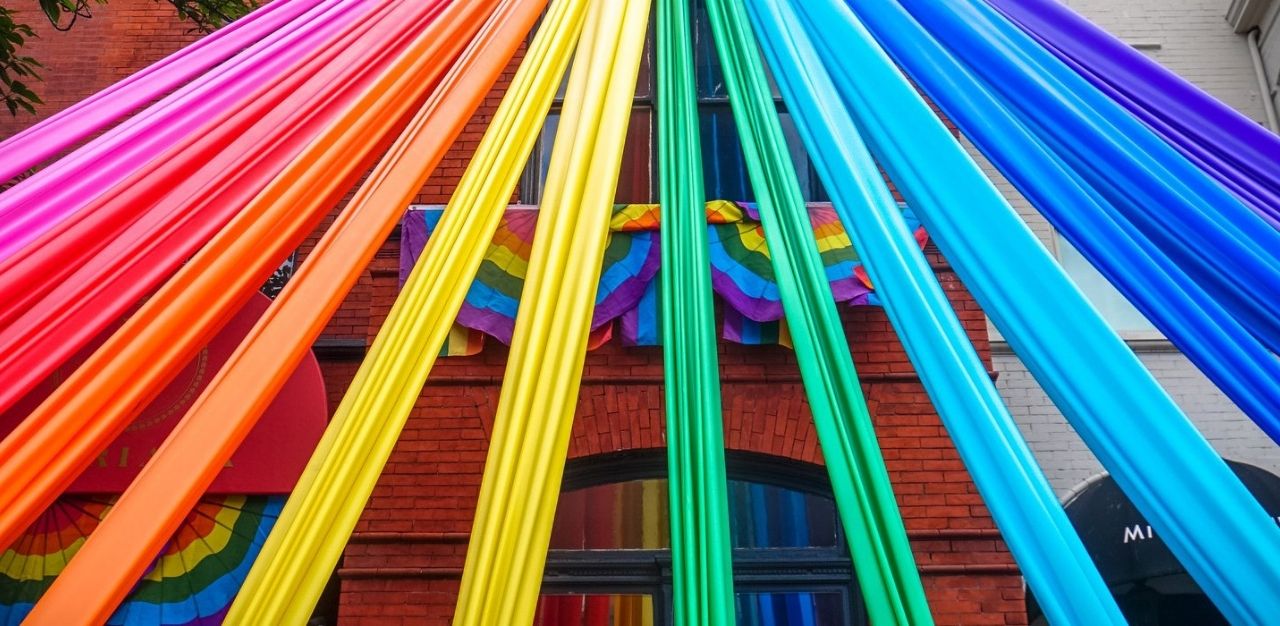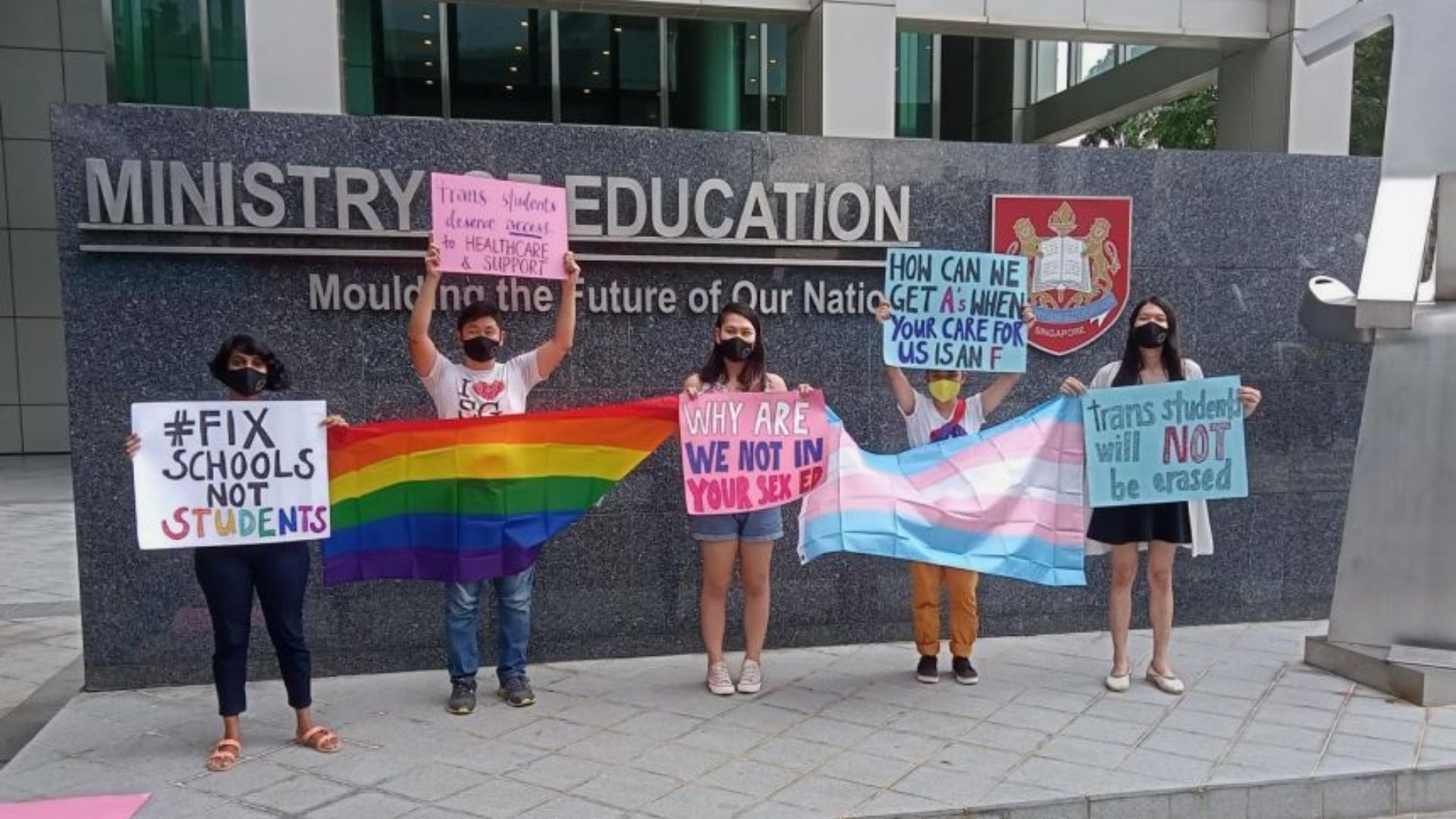A young queer person schooling in conservative Singapore is likely to face a whole gamut of discrimination—from verbal abuse and bullying to the more insidious forms of ostracism, such as the fear of being outed before they are ready and the lack of acknowledgement of their existence.
For gender non-conforming student Elijah Tay, their secondary and junior college years were marked by memories of gender policing by teachers. This is the act of enforcing normative gender ideals based on the gender binary. For Mx Tay, cutting their hair short alleviates feelings of gender dysphoria, but their gender expression was frowned upon by school leaders, who only saw them as a student who was assigned “female” at birth.
One of the worst instances, they recall, was when they were forced to apologise for their haircut and were even denied leadership roles due to their appearance. Although they were otherwise well-behaved in school, Mx Tay was made to write an apology for their hairdo. “Many boys in school had the same haircut as I did, but only I had to write a reflection and say sorry. I thought that was pretty unfair, it ruined my perfect school record,” Mx Tay says.
“Transgender and gender non-conforming students are particularly at risk for not feeling safe in schools, as schools are rarely (if at all) accommodating to the needs of gender-diverse students,” says youth worker Alex Teh from non-profit organisation Oogachaga. The organisation provides counselling services to the LGBTQ+ community and has supported many youths struggling within the Singaporean education system.
Mr Teh notes that some common practices that harm trans students are using a student’s dead name, the wrong pronouns and gender-binary uniforms and toilets.
Students in Singapore are not given the opportunity to explore their gender and sexual identities and are treated on the basis of their sexual orientation, gender identity, and/or gender expression, he added. The pernicious impacts on queer students who feel unsafe at schools are well-documented, and these include psychological distress, increased anxiety, and higher rates of self-harm behaviours such as substance abuse and suicidal ideation or attempts.
Gloom-ridden stories are the norm for queer students
Mx Tay’s experience is just one of the many negative stories among queer students in Singapore, and might even be considered a less severe one. Earlier this year, 18-year old transgender student who wanted to be known only as Ashlee shared that her junior college denied her the right to receive hormone replacement therapy (HRT) while continuing her education at the school.
Ashlee’s story quickly gained virality, which prompted the Ministry of Education (MOE) to issue a response denying their interference in her HRT. The final medical treatment decision involving the use of HRT rests with clinicians and their patients, the ministry added.
In response to a parliamentary question about the MOE’s policies and guidelines on students with gender dysphoria, then Minister for Education Lawrence Wong said, “schools can exercise flexibility and work out practical arrangements for these students.”
Despite the public outrage, Ashlee was coerced by her school to opt for home-based learning (HBL) and was finally denied that on the grounds that it was “not fair” to other students. She was then told to cut her hair if she wanted to return to school, and that her absence from school (because she was denied entry) was considered “without valid reason”.
“Flexbililty” in this case meant that the school was allowed to have inconsistent policies, and could blatantly discriminate against Ashlee by denying her access to a fair meritocratic education if she did not conform to a system that only caters to cisgender students.
Adolescence is in itself a trying and vulnerable time for many; and worse for LGBTQ+ youths struggling with their journey of self discovery and identity. Fearing for their own safety in the place where most of their time is spent hinders their ability to live full and enriching lives.
With the odds stacked against them, queer students do not have the same opportunities for success in education as their cisgender and heterosexual (cis-het) peers. “When I come across queer students who express how fortunate they were to have had supportive teachers, it makes me glad, yet disappointed. No queer student should have to consider themselves ‘lucky’ to receive such assistance. It should be the norm. If cis, straight students can come to school feeling safe, why can’t the same support be given to queer kids?” asks a non-binary student who declines to be identified.
During yet another speech by Mr Wong at the IPS-RSIS Conference on Identity, this time as Singapore’s Finance Minister, he pointed out that the LGBTQ+ community has its own “real and valid concerns and anxieties,” and that, “[the government] will never let any group feel unheard, ignored or excluded. We will never let any group feel boxed in or ostracised.”
“All must feel they are part of the Singapore conversation; all must feel they are part of the Singapore family; all must feel there is hope,” he said.

Yet, positive stories from queer students’ time in the Singapore education system are the exception, not the norm. The lack of clear policies to support queer students, absence of role models as LGBTQ+ teachers feel pressured to remain closeted and hidden for fear of losing their jobs, the fact that MOE schools aren’t allowed to refer students to Oogachaga’s LGBTQ-affirming counselling services are just some reasons the LGBTQ+ community remains excluded from “the Singapore family”.
Apart from that, discrimination can come from many parties, mainly teachers, ministry-level guidelines and policies, broader social conventions, and other students who are socialised to reject students who are different from them.
Teachers as the biggest bullies
Many students that we spoke to highlighted that teachers and school leaders were the major source of bullying and discrimination. An earlier article by Singapore-based queer brand Heckin’ Unicorn corroborates the fact that some teachers and educators can be the “most cruel perpetrators of abuse and bullying against LGBTQ+ students in Singapore”—and can do so without consequence.
The unequal power dynamics between teachers and students mean that students are not able to stand up for themselves or their peers, and the damages are profound. Students who try to question teachers or correct them when they misgender the students themselves or other students are quickly put in their place and faced with hostility rather than openness.
Some actions include outing a student to their parents and peers before these individuals are ready, letting bullying slide or even enabling bullying by making transphobic and homophobic remarks, and gaslighting queer students by dismissing their emotions.
“That’s why many students stay closeted and refuse to engage with these emotions and thoughts at a young age. They fear that if someone finds out, the information might be disclosed before you want it to,” says a student who wants to be known as N.
“Teachers themselves were the main source of the trauma that I faced. They could paint my gender expression as a discipline issue and threaten me to get me to conform. I tried to raise some of these cases to my vice principal before I left the school, but I was just gaslighted throughout,” says Mx Tay.
In response, Mx Tay was told that what they faced did not count as discrimination and they should not feel so hurt by these incidents.
“I had an openly gay male friend in a junior college (JC) who was threatened by another student. Sadly, he wasn’t supported by the school, but instead advised to understand that his sexuality would sometimes incite backlash. I thought that was a terrible response from the school at the time,” said a university student, who only wanted to be known as Ms Celeste.
Such responses feed into the notion that being queer is inherently “wrong” and perpetuates discrimination in the school environment. Not only does that affect the queer student’s internalised homophobia, but it teaches other students that it is perfectly acceptable to keep bullying and treating LGBTQ+ persons as lesser than them.
The queer students that we spoke to who were schooled in a religious school environment expressed that the discrimination they faced was ten-fold.
“Teachers and religious peers were often homophobic and heavily disapproved of the queer community. The teachers were quick to correct and reprimand girls who seemed to be queer or who were “overly-affectionate with each other”. Without a comprehensive school curriculum on queerness, I treated my attraction to different genders as problematic. At 15, I was deeply infatuated with another female but I thought it too risky to express anything. I particularly feared the school finding out and reporting it to my religious parents,” said Ms Celeste, who attended an all-girl Catholic school.
Between a rock and a hard place
At the same time, teachers are put in a difficult position as they have a responsibility to multiple stakeholders, such as parents, students themselves and MOE, says a teacher that we spoke to.
“Within public education, parents are the loudest stakeholders because they have the right to make demands,” they say. “If parents keep expecting teachers to ensure that their children grow up and live these model fantasy lives of straight A’s, no relationships or exploration of sexual and gender identities, then even if teachers wanted to do something different, they can’t,” the teacher added.
While there are definitely many instances of teachers targeting queer students, many teachers are merely following existing rules and policies that are already in place. “The fact remains that teachers who do want to be supportive and affirming are still limited by the absence of a standardised protocol backed by the school or MOE to help them support young LGBTQ+ students. Teachers, allied educators, and school counsellors also fear facing negative consequences from being perceived by management as trying to ‘promote being LGBTQ+’”, says Mr Teh.
A joint Universal Periodic Review report by LGBTQ+ organisations Oogachaga and Pink Dot SG found that although teachers and counsellors are said to be given “very extensive training” to handle bullying related to gender identity or sexual orientation, there are no publicly available details from the MOE about how this is done. There is also no official or clear MOE policy against discrimination and censorship of LGBTQ+ content in the educational context.

Silence breeds uncertainty and harm
With a lack of top-down guidelines by the ministry, teachers are often at a loss when faced with situations of bullying and discrimination. They sweep LGBTQ+ related issues under the rug, which creates an even more harmful environment for queer students.
A teacher from the collective Queer Friendly Chers says that they, too, would not know how to handle cases of bullying or discrimination as they had not received guidance on such cases and “there aren’t policy-level decisions”. This often results in dealing with the issue on a case-by-case basis which is driven by the principal and the school culture, and if the LGBTQ+ students are in more conservative schools, they are exposed to greater harm.
Without resources and open conversations within the education system, most queer youths have had to gather information from the internet and social media themselves. “The resources won’t come to you, you have to look for it yourself,” says Mx Tay.
“Since schools have always avoided talking about the queer community, I only started learning the terms later in my educational years. I used to feel confused about myself and the way I was. I always felt that [there is] something different about me. I actually found out more about myself and my queer identity through the internet,” says N.
“I have always wished that schools were inclusive of people like me. Back then, I did not know the term non-binary. I always felt like I didn’t fit into the norm. I wish there was more information and education on sexuality and gender identities in schools then. If this was present in schools, I would have had an easier time dealing with the issues I was facing with my gender identity. It would have encouraged me to accept myself as I am and know that there is absolutely nothing wrong with who I am,” they say.
Sex education failing queer students
There was a consensus among all the interviewees that the current sexuality education programme (sex-ed) is not enough as it heavily focuses on abstinence and heterosexual relationships. Ex-students who went through sex-ed years earlier even mention that in the worst scenarios, teachers conducting sex-ed spread misinformation about bisexuality and homosexuality, saying that they were “just phases” and that people grow out of.
“We should move away from a model of teachers telling students that they shouldn’t engage in sexual activities at all because that’s not the reality that students face. Rather, students should be empowered to make more educated choices and be taught how to handle different situations. If not, they won’t have the tools or understanding of what to do beyond the script of ‘don’t have sex with the opposite sex’,” says a teacher who prefers to remain anonymous.
“By that point, students are so fearful to even bring things up. If they’re in dangerous or complicated situations, they might choose just to suffer in silence,” the teacher adds.
Earlier this year, gender equality organisation AWARE facilitated discussions with 17 students, aged 16 to 26; 10 current and former teachers who had experience teaching sexuality education; and 21 parents of children across all ages. All of them weighed in on the limitations of current sexuality education programmes in schools.
Among the many concerns that surfaced, the ones that relate to the safety of queer youths are sex-negativity. This teaches students that sex is a risky and damaging activity that should be avoided because it leads to pregnancy and/or dangerous diseases and destroys one’s future.
The second concern is that LGBTQ+ students still feel unwelcome during sex-ed classes and are unable to seek support from teachers.
Broader social policies to blame
While fellow students and teachers are the main sources of bullying for queer students, broader social policies in Singapore discriminate against LGBTQ+ people and creates a society that inadvertently does the same.
Heckin’ Unicorn’s article cover a range of ways in which institutionalised discrimination exist in Singapore and how the broader system — intentionally or not — actively discriminates against queer people.
These students and teachers are products of their environment and are acting based on what they have been taught to believe — that queer folks should not have the same rights as everyone else.
“As much as I’m frustrated about how ignorant people are in school and how their ignorance created an unsafe space for people like me, I also understand that it’s the wider system, education, policies and even media portrayals that shape people’s understanding of the world and creates a cis-heteronormative mindset from a very young age,” says Mx Tay.
Agreeing, another teacher who does not want to be named for fear of losing their job, says, “Change has to start from the top. The government has censored a Marvel film. Within such a framework, how can we have a safe system in place for LGBTQ+ youths? It is left to the individual educators to work within this system to urge tolerance and open-mindedness.”

Pockets of safety
Without institutional support, queer social media pages run by queer students, who are craving a sense of community in particular schools, have sprouted up. These include Rainbow NYJC, Nanhua Queers, Marymount Gayte, Swiss Pride, TKK LGBT, Temasek JC LGBT and Dunman High LGBTQ.
Living through a pandemic further complicates the safety of students who may be living in homes where family members are not supportive of their identities. It is no wonder that more social media accounts, podcasts and initiatives were created early last year to provide safe respite.
Even so, Mx Tay says that finding resources on social media might be a challenge as it is dependent on algorithms and students would need to know what to search for.
This is the first of a two-part series on the LGBTQ+ youth in Singapore and providing them with a safe learning environment they need.
Join the conversations on TheHomeGround Asia’s Facebook and Instagram, and get the latest updates via Telegram.




























